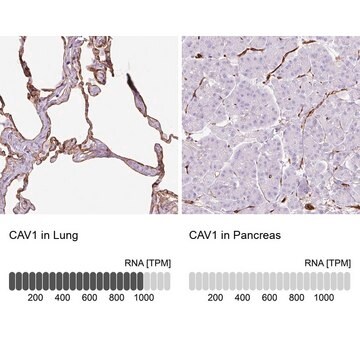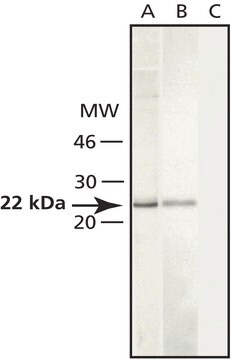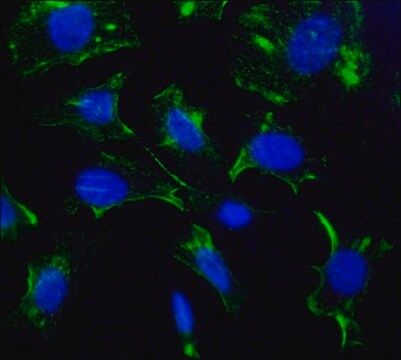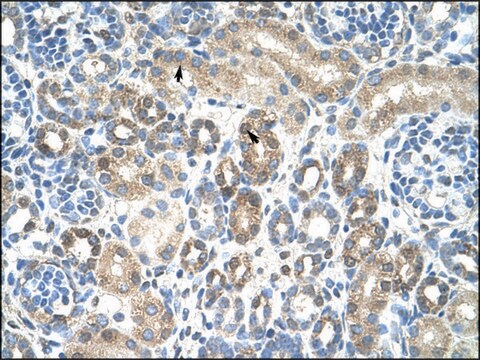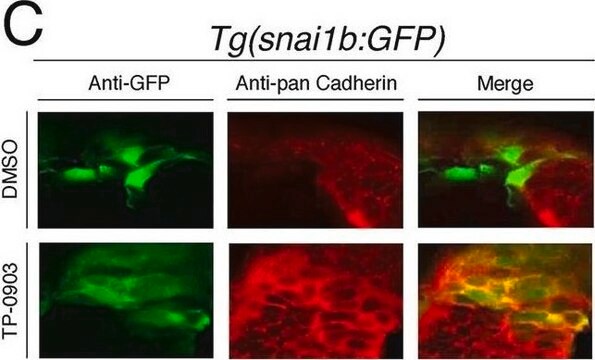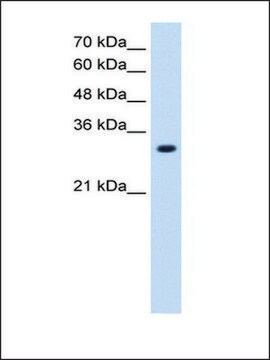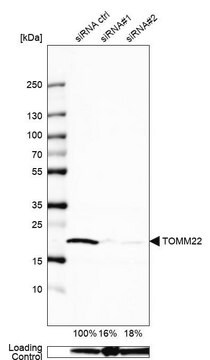推薦產品
生物源
rabbit
共軛
unconjugated
抗體表格
IgG fraction of antiserum
抗體產品種類
primary antibodies
無性繁殖
polyclonal
形狀
buffered aqueous solution
分子量
antigen 22 kDa
物種活性
human, rat, mouse
加強驗證
independent
Learn more about Antibody Enhanced Validation
技術
indirect immunofluorescence: 1:500 using mouse fibroblast NIH3T3 cell line
microarray: suitable
western blot: 1:2,000 using whole cell extract of the human umbilical vein endothelial HUVEC cell line and the rat fibroblast Rat-1 cell line
UniProt登錄號
運輸包裝
dry ice
儲存溫度
−20°C
目標翻譯後修改
unmodified
基因資訊
human ... CAV1(857)
mouse ... Cav1(12389)
rat ... Cav1(25404)
尋找類似的產品? 前往 產品比較指南
一般說明
Anti-Caveolin-1 is developed in rabbit using a synthetic peptide corresponding to a region at the N-terminus of human caveolin-1 conjugated to keyhole limpet hemocyanin (KLH) as immunogen. Caveolin-1 (CAV1) is a multifunctional scaffolding protein, that has three exons. It is located on chromosome 7q31.
Caveolin, a 20-24-kDa integral transmembrane protein, has been identified as a principal component of caveolae membranes. Caveolin (also termed VIP21) exists in several isoforms termed caveolin-1, caveolin-2 and caveolin-3. Caveolin-1 (20-22 kDa) can exist as two isoforms, caveolin-1α and -1β due to alternative splicing of the mRNA.
特異性
The sequence is highly conserved in many species, e.g., identical in rat, mouse, bovine, and dog caveolin-1. The sequence is not found in caveolin-2 or caveolin-3.
免疫原
synthetic peptide corresponding to a region at the N-terminus of human caveolin-1 (amino acids 2-20).
應用
Anti-Caveolin-1 antibody produced in rabbit has been used in:
- indirect immunofluorescence
- in confocal microscopy
- western blotting
生化/生理作用
Caveolin family members function as scaffolding proteins to organize and concentrate specific lipids such as cholesterol and glycosylphosphatidylinositol (GPI) and lipid modified signaling molecules within caveolae membranes. Staining of caveolin-1 in immunoblotting is specifically inhibited with caveolin-1 immunizing peptide (human, amino acids 2-20).†
Caveolin-1 is expected to play a major role in the growth and evolution of cancer. It participates in glucose metabolism. It may also participate in angiogenesis. Cav-1 helps to control the expression of glucose transporters.
外觀
0.01M 磷酸缓冲盐溶液,pH 7.4,含 15mM 叠氮化钠。
免責聲明
Unless otherwise stated in our catalog or other company documentation accompanying the product(s), our products are intended for research use only and are not to be used for any other purpose, which includes but is not limited to, unauthorized commercial uses, in vitro diagnostic uses, ex vivo or in vivo therapeutic uses or any type of consumption or application to humans or animals.
Not finding the right product?
Try our 產品選擇工具.
儲存類別代碼
10 - Combustible liquids
水污染物質分類(WGK)
WGK 1
閃點(°F)
Not applicable
閃點(°C)
Not applicable
分析證明 (COA)
輸入產品批次/批號來搜索 分析證明 (COA)。在產品’s標籤上找到批次和批號,寫有 ‘Lot’或‘Batch’.。
Zui Pan et al.
The Journal of biological chemistry, 279(19), 19387-19390 (2004-03-25)
Perturbation of intracellular Ca2+ homeostasis has been shown to regulate the process of cell proliferation and apoptosis. Our previous studies show that mitsugumin 29 (MG29), a synaptophysin-related protein localized in the triad junction of skeletal muscle, serves an essential role
Camila de Souza Palma et al.
Molecular & cellular proteomics : MCP, 15(3), 906-917 (2016-01-15)
Epithelial to mesenchymal transition (EMT)(1) occurs naturally during embryogenesis, tissue repair, cancer progression, and metastasis. EMT induces cellular and microenvironmental changes resulting in loss of epithelial and acquisition of mesenchymal phenotypes, which promotes cellular invasive and migratory capabilities. EMT can
Rac1 participates in thermally induced alterations of the cytoskeleton, cell morphology and lipid rafts, and regulates the expression of heat shock proteins in B16F10 melanoma cells
Gungor B, et al.
Testing, 9(2), e89136-e89136 (2014)
Co-expression of MG29 and Ryanodine Receptor Leads to Apoptotic Cell Death EFFECT MEDIATED BY INTRACELLULAR Ca2+ RELEASE
Pan Z, et al.
The Journal of Biological Chemistry, 279(19), 19387-19390 (2004)
Burcin Gungor et al.
PloS one, 9(2), e89136-e89136 (2014-03-04)
Eukaryotic cells exhibit a characteristic response to hyperthermic treatment, involving morphological and cytoskeletal alterations and the induction of heat shock protein synthesis. Small GTPases of the Ras superfamily are known to serve as molecular switches which mediate responses to extracellular
我們的科學家團隊在所有研究領域都有豐富的經驗,包括生命科學、材料科學、化學合成、色譜、分析等.
聯絡技術服務
